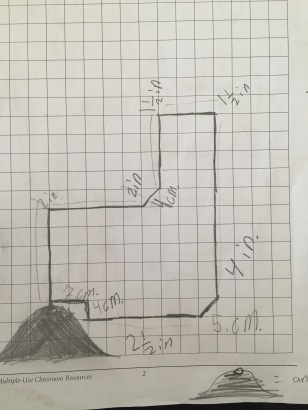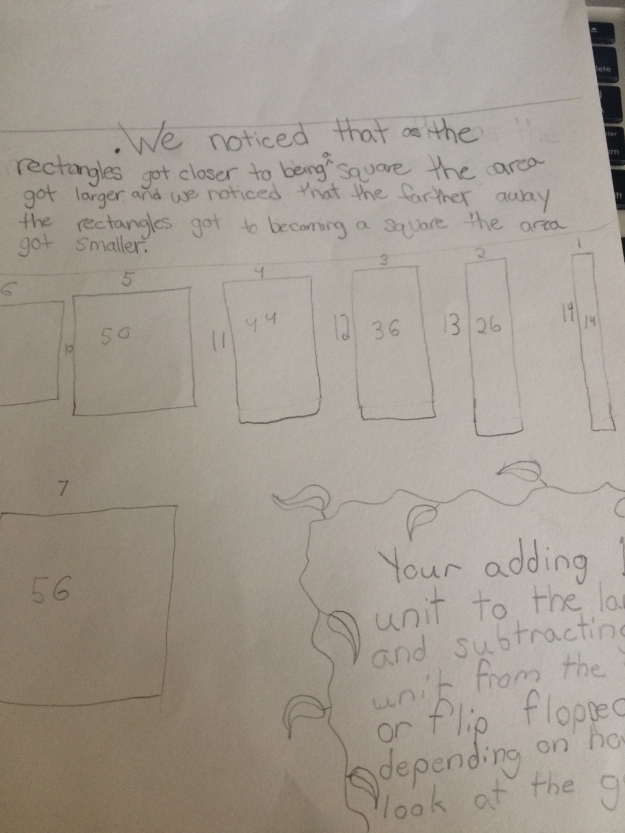Last week, I posted about a 3rd grade lesson I planned and taught with Hope and Lori. We did not get to everything we planned so I love that they filled me in on what happened the next day when they continued the work! And when the continuation involves looking at student work, I love it even more! That said, this will be a bit of a student work-heavy post with things I noticed and wondered in steps moving forward from here with the students…
After measuring a piece of paper in the previous lesson, we wanted to ask students how they would find the distance around any-sized piece of paper. In giving them the journal writing, we wanted to have them reflect on the measuring and calculating they did in a more general sense and see how they put the process into words. Most student papers resembled the explanation in piece of work below:

It was really interesting to find most students drew a picture to illustrate their explanation even when not asked to do so. To me, this is a nice mix of show your thinking and show your work. In reading this example below, this student is thinking a lot about conversions and I think, moving forward, the class needs to have a discussion about combining different measurement units.
The mix of units shows up again below. I can see they probably chose centimeters because they didn’t have a smaller unit than the inch and didn’t know how to name the measurement in inches. I love the “not really the size” but I wonder about the border look of the perimeter. Is this student seeing the 6 inches and 3 cm ending where the line is and counting boxes instead of the distance around?
This one is an amazing look at how the formula we all know, and probably had to memorize, arises in third grade. The calculation on the back was equally as nice. This is an example of something during a class share that I would show last in a progression to compare with the previous strategies as it does a nice job of showing the process of finding perimeter in two ways.
This one was so interesting because it involved a square and a circle. The measurements on the back were most intriguing and I have so many questions for this student. Like, how do you know that is a square? (because the sides are not the same length) Where is the 1/2 coming from in your answer? (because I cannot tell where he is stopping and starting his measuring) and Why did you want to cut a circle and a square?
Then, Hope asked them to draw their own ant path and some really interesting things came out that will have to be a blog post in and of itself! There are things we didn’t think about in our question and some things we really need to think about moving forward. Like…
Could this student start thinking about area? Why did the choose to draw a non-rectangular path?

Where are the measurements for each side? Why did you label them where you did? Why did you choose to use inches and centimeters?

When did you choose to use inches and when did you choose centimeters? Could you have measured it all in inches? all in centimeters?

First, the fact the student sent the ant to Walmart is too funny:) I would love to ask this student how he or she added all of those side lengths? and Why was it longer to get home from Walmart than it was to get there? Could the ant have walked the same distance there and back? How?

On this one, we did not anticipate students’ ants taking the same path back that he did out. So this is important to think about distance and versus distance around something.

Oh, an isosceles right triangle, how fun! I would love to ask this student about this perimeter in centimeters because of the diagonal cuts in the boxes. A lot of students counted the diagonals as 1 unit like they did for the sides of the boxes, so would that work out if you measured it with a ruler in centimeters? Why?

My question is where to go with a student who is here? All teachers face this, right? There are some students who conceptually and computationally have a grasp on an idea. This student can obviously find perimeter and is very comfortable with the computation piece of it, so what do you ask him from here? Do you give him things to measure that closer to a quarter and see how he works with the fractions? Do you ask him if his strategy will work for every shape? (I lean toward this one) Do you ask him about non-rectangular polygon areas? Do you do anything with area at this point? So much to think about!

~Kristin




































